
While SA may be lagging behind in terms of physical deployment of long-term evolution (LTE) technology, it is ahead of the curve with its physical IT infrastructure, which has been vastly improved by new entrants in the industry.
This is according to Gary Williams of independent fibre operator Metrofibre Networx. Williams, who is also marketing co-chairman and founding member of the Metro Ethernet Forum (MEF) in SA, says the country needs a more formalised national broadband policy to "open the gates" in order for technologies like LTE to become more accessible to operators.
"The industry has made huge efforts to get all its ducks in a row; now we need the government to do its part and release the mobile spectrum, which will join our wired and mobile networks together."
United platform
Metrofibre Networx, the first adopter of MEF standards in SA, is driving the adoption of "world conformity", whereby it advocates every service provider and carrier be interconnected via the same MEF Carrier Ethernet cloud.
Williams says uniting disparate provider networks is the key to driving down the cost of bandwidth in SA. "This will also mesh together the country's networks and provide the countrywide network, which is so desperately needed to boost the economy."
The only way to achieve this, he says, is by having all stakeholders use one language. "This would mean there would be no need to interconnect with equipment that speaks different languages, and businesses would have transparent service-level agreements and quality of services."
Williams says the provision of an effective framework by the government will enable local organisations to compete on a global scale. "If the government provides the framework, the MEF can galvanise the telcos, ISPs and equipment manufacturers to join up islands of connectivity into a national network that can compete in a globally connected business environment."
National LTE
First and second cellphone operators, Vodacom and MTN, are both tabling LTE for rollout within the next three months. Vodacom says its network will be 100% LTE-ready within the next year, and MTN - which started trialling LTE technology last year - has said it is on track to switch on a commercial LTE network by year-end. Both operators have only earmarked three cities - Johannesburg, Pretoria and Durban - for their initial rollout.
While SA's third mobile operator, Cell C, is the latest to make its LTE intentions public, the company says there are a number of problems to consider in terms of a national LTE network in SA. Cell C CEO Alan Knott-Craig says it is unlikely that any South African operator will build a national LTE network anytime soon.
"Cell C, like the other operators, will be rolling out LTE towers in select areas over the next few months, covering areas where there is fibre to the base station. However, it is unlikely that any SA operator will build a national LTE network anytime soon.
"Firstly, and most importantly, there isn't enough national fibre to support a national LTE network. Wireless technologies are useless without backhaul that isn't fast enough. While there are several companies and consortiums installing national fibre across the country, it is unlikely to be able to sustain an LTE network until at least 2014."
Knott-Craig says that, while LTE is the first technology built specifically for wireless broadband, there are still very few handsets that support the technology available in the market, other than the iPhone 5 and "possibly" the new BlackBerry 10 devices.
"Also, the plans to split up the spectrum that could be used to rollout a national network (ie, spectrum in the 800MHz and 2.6GHz bands) in an auction could make the cost of rolling out a national network extremely high. (The more you split the spectrum, the more operators have to invest to make the smaller amounts of spectrum work on a larger scale.)"
Ultimate ideal
Ideally, says Knott-Craig, Cell C would like to see the spectrum given to a consortium of companies that could roll out a national wholesale LTE network.
"The price of the access to the wholesale network could be regulated before the rollout and the regulator could also stipulate the footprint of the network. Any company could then compete at a service level by leasing access to the network."
He says this will accomplish several things. "Firstly, the cost of the rollout would be split between all the companies participating, making it more likely that rural areas would be covered.
"Secondly, it would also help keep the price of services on the network lower at a retail level, which will promote competition at a service level. And thirdly, the regulator could avoid bickering over spectrum. Finally, there would be only one set of towers that need to be built, instead of one tower per operator, which we did for 3G.
"The concept is working with fibre providers with a consortium like FibreCo, so why couldn't it work for LTE?"
Cell C is set to make further announcements about its LTE rollout plans in the coming weeks, says Knott-Craig.
Share